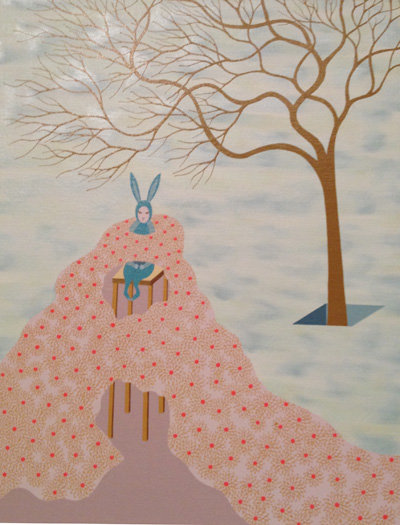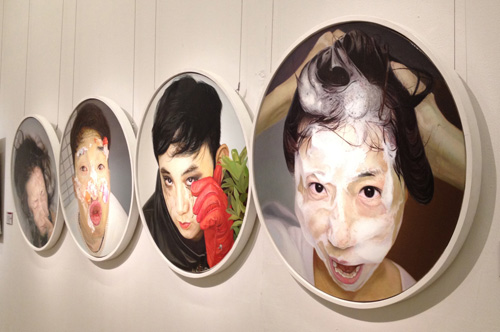|
 |
|
Tales of Two Castles by Yu Hua |
"I was born in 1984 and one year later, fruit jelly was introduced to China," said Yu. "Jelly has been with me for my whole childhood."
"Jelly is made of water, sugar, fruit juice and additives. It includes all this stuff but looks transparent. It is just like the life of my generation," said Yu. "Many of us refuse to grow up because childhood was so short while adulthood seems to be endless. We experienced a lot but we still try to stay pure and transparent, so we always feel isolated while at the same time we are eager for freedom. It is a conflict."
Yu said the paintings on display are a reflection of inner isolation and thought. She named the group of paintings Tales of Two Castles.
"Deep inside me are two castles, one with a wall and the other with a moat. When I confront myself, I see the walls of the first rising before me, with countless peaks that I must conquer," said Yu. "Once I have ascended to a certain level, the road evens out, and then I feel a sense of satisfaction. The path is full of pleasure as well as invisible traps, so I must remain on guard, and keep learning, in order to fulfill my potential. In this inner world, only I alone can solve my problems."
 |
|
Foam Memory by Tian Yuanyuan |
Compared with Yu, 25-year-old Tian Yuanyuan's memories of the old times are more people-oriented. Her collection of artwork, called Foam Memories, includes four paintings of foam products like facial cleansers and birthday cakes.
"I use foam to reflect the conflict in young people—we try to protect ourselves with a foam cover but at the same time we are very curious about the outside world," said Tian. "That is why we dare to try almost everything. When we look back upon our youth, what we most cherish is not only the years that have passed, but also our curiosity and courage."
East and West
Though originally a Western art form, oil painting has unavoidably merged with traditional Chinese painting styles. Huang Shaopeng's painting is a replication of Shussan Shaka-zu, or the Shakyamuni Buddha, originally painted by Liang Kai from the Southern Song Dynasty (1127-1279). Originally an ink painting, the work depicts Shakyamuni Buddha stopping an eagle from eating doves by offering his own flesh to the predator.
"I was deeply moved by the story," said Huang, who prefers painting spiritual subjects. "The combination of Chinese brush painting with oil painting is not new in China, and it is not a conflict at all."
Fang Shaohua, a professor at the Fine Art Institute of South China Normal University, showed a collection of his five paintings titled Bamboo Without Regulations. Like bamboo, the title suggests art shouldn't follow strict rules, but rather grow wildly. The paintings represent bamboo growing in varying climates and conditions, such as rain, snow and wind.
"I learned Chinese painting when I was a kid. I was required to follow the rules set in The Mustard Seed Garden, a well-known guidebook of ink painting compiled during the early Qing Dynasty (1644-1911) and regarded as the Bible of Chinese painting," said Fang, who added that he disagrees with the excessive rules put forth in the manual.
"Those regulations are more like restrictions than instructions," said Fang, who said it is one of the reasons he named his paintings Bamboo Without Regulations.
"I didn't follow the rules of ink paintings, but I still use a brush to paint. I would like to show the charm of ink painting in a different way," said Fang. "We can't say oil painting is Western and ink painting is Eastern. They definitely can combine very well."
Email us at: yuanyuan@bjreview.com | 